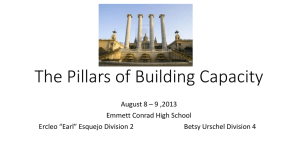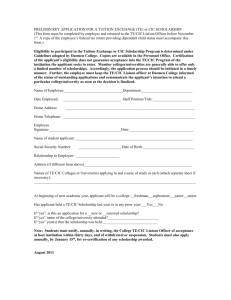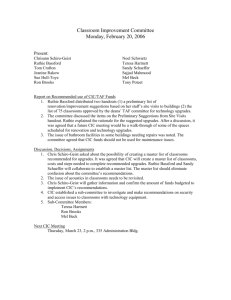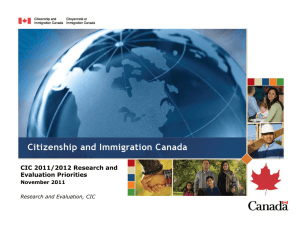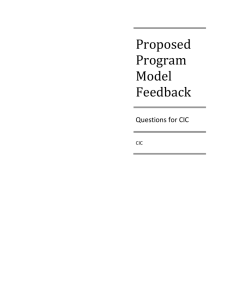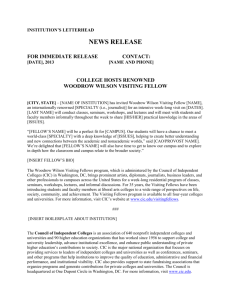Document management in a computer
advertisement
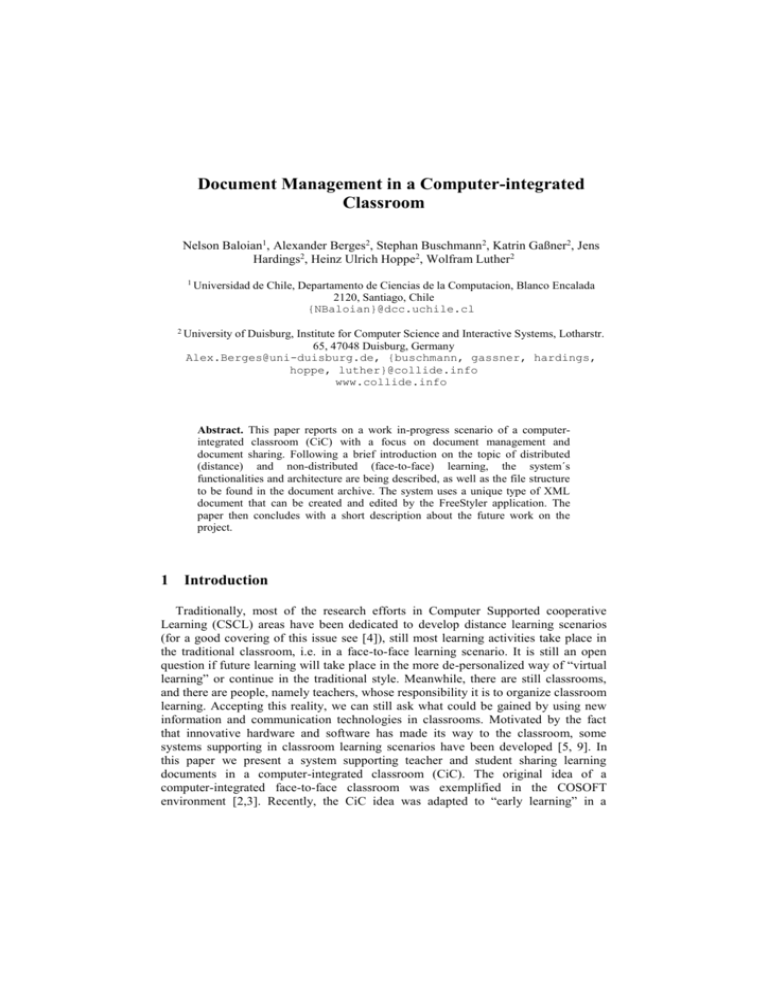
Document Management in a Computer-integrated
Classroom
Nelson Baloian1, Alexander Berges2, Stephan Buschmann2, Katrin Gaßner2, Jens
Hardings2, Heinz Ulrich Hoppe2, Wolfram Luther2
1 Universidad
de Chile, Departamento de Ciencias de la Computacion, Blanco Encalada
2120, Santiago, Chile
{NBaloian}@dcc.uchile.cl
2 University
of Duisburg, Institute for Computer Science and Interactive Systems, Lotharstr.
65, 47048 Duisburg, Germany
Alex.Berges@uni-duisburg.de, {buschmann, gassner, hardings,
hoppe, luther}@collide.info
www.collide.info
Abstract. This paper reports on a work in-progress scenario of a computerintegrated classroom (CiC) with a focus on document management and
document sharing. Following a brief introduction on the topic of distributed
(distance) and non-distributed (face-to-face) learning, the system´s
functionalities and architecture are being described, as well as the file structure
to be found in the document archive. The system uses a unique type of XML
document that can be created and edited by the FreeStyler application. The
paper then concludes with a short description about the future work on the
project.
1
Introduction
Traditionally, most of the research efforts in Computer Supported cooperative
Learning (CSCL) areas have been dedicated to develop distance learning scenarios
(for a good covering of this issue see [4]), still most learning activities take place in
the traditional classroom, i.e. in a face-to-face learning scenario. It is still an open
question if future learning will take place in the more de-personalized way of “virtual
learning” or continue in the traditional style. Meanwhile, there are still classrooms,
and there are people, namely teachers, whose responsibility it is to organize classroom
learning. Accepting this reality, we can still ask what could be gained by using new
information and communication technologies in classrooms. Motivated by the fact
that innovative hardware and software has made its way to the classroom, some
systems supporting in classroom learning scenarios have been developed [5, 9]. In
this paper we present a system supporting teacher and student sharing learning
documents in a computer-integrated classroom (CiC). The original idea of a
computer-integrated face-to-face classroom was exemplified in the COSOFT
environment [2,3]. Recently, the CiC idea was adapted to “early learning” in a
primary school classroom [10] as well as to academic lecturing [7]. We share the
same principles which are behind the development of systems like Classroom2000 [1]
and the electronic classroom used by ITM [13] about ubiquitous computing in the
classroom [12]. However, Classroom2000 is oriented to capture the lecture and store
it in files and the ITM classroom is oriented to remote lecturing. In our project we
address the problem of document management (distribution, collection, sharing)
inside (and outside) the classroom. It differs from the traditional courseware creation
and managing systems in that it combines traditional face-to-face lecturing with
computer supported collaborative learning. In a CiC setup the teacher presents the
learning material (multimedia documents) on an electronic blackboard. Every student
has a notebook or PDA, while the technical system provides the functionalities of
interaction among the multiple computers. A wireless LAN connects the student’s
computer with the electronic blackboard, and there is a server (outside the local
network) which provides and stores learning material. A CiC also includes systems
which help teacher and students to recover, manage and share learning material.
The CiC combines positive aspects of the classical chalkboard approach,
particularly its flexibility in the spontaneous elaboration of ideas, with the potential of
modern networked multimedia. The value added lies in the avoidance of
discontinuities in representations (“media breaks”). In the CiC approach presented
here, re-use and exchange of results, either synchronous or asynchronous, is easily
possible. The full spectrum of basic representations, ranging from freehand input to
sophisticated simulation and animation is available.
Fig. 1. The computer-integrated classroom scenario.
The work presented in this paper was motivated by concrete experience from a
lecture about programming in distributed systems held at Duisburg University.
Many problems occurred which could have been avoided by having an
administration system for the learning material of the course. The same group is
now designing and developing the CiC system for this particular case. The work
reported here focuses on the teacher’s work-plan (in a classroom).
Although the CiC is still work in progress, most functionalities have already been
implemented. The next chapter will introduce the use cases, that have been extracted
as important needs. Chapter 3 will deal with the implementation of the system
presenting its architecture, modules, and implementation of some important
functionalities. Chapter 4 will briefly present some characteristics of the documents
which are administrated by the system and the tool used to present and manipulate
them. Chapter 5 will present some conclusions and future work.
2
The System Functionalities
The basic functional requirements for the envisaged CiC scenario can be broken down
into the eight items listed below, each corresponding to a typical “use case”:
Registration of teachers, courses, and students. In order to facilitate the document
handling and management it is necessary to first register teacher, students and courses
to the Document Manager. This module also maintains information about what
courses are taught by each teacher, and the students that participate in each course.
Login procedures for students and teacher. Teacher and students have to login to
start a teaching and learning session. The teacher can establish a classroom session
which the students may join. The username and password credentials determine
access rights to files and directories within courses’ and students’ files, inside as well
as outside the classroom.
Distributing/collecting documents. During a classroom session the teacher can
distribute and collect documents of any type to and from the students. Documents can
be located at the Document Manager or in a local directory, either at the teacher’s
electronic blackboard or on the students’ computer.
Sharing documents. By sharing a document we understand many people viewing
and modifying the same document at the same time. This can be used when the
teacher asks a student to present his/her work to the rest of the class. Discussions can
be supported by allowing other students or the teacher to use the document being
shown, adding notes and drawings to further explain their idea.
Monitoring the students’ work. During a classroom session, a teacher can look at
student’s work within a document, for example to examine the progress made on an
assignment or to verify the correctness of work in progress. A teacher is also able to
collect parts of documents from the students, increasing his ability to monitor the
work by comparing different approaches
Questions and answers. A module named “Questions and Answers” allows students
and teacher to interact in a chat-like manner. The conversation details can be saved
for a later analysis of the written interaction inside the classroom.
Working outside the classroom. Users should have the possibility to create and
modify learning material wherever they are. For this reason, we have implemented an
interface that enables the user to access and edit the learning material via the internet.
However, the tool does not include a synchronous remote learning environment via
video or audio conferencing, it solely enables users to continue and edit their work
started in the classroom environment.
Logging the actions during a session. We will provide mechanisms for keeping
track of relevant information about the actions taken during the lectures by the teacher
and the students for a later analysis. Conclusions can then be drawn about how the
lecture was organized. For example, it is important to record which documents were
opened during a session, how many times they were opened during the whole course,
and how many times they were modified. This can provide us with valuable
information about which files need to be replaced, complemented, or deleted.
3 The System Architecture
As a result of our practical experience we assumed the system should consist of at
least one classroom local area network (Classroom Environment), desirably secured
by a firewall which is again connected to a Document Manager (see 3.1). Adding to
this we wanted to present the users the ability of asynchronous and distributed work
on their documents, i.e. via an internet connection outside the classroom. The
component developed for this purpose is situated in the Home Environment.
3.1
The Modules of the System
The System is organized into different components, placed into three
environments: classroom environment, server and home environment. The
functionalities of the components shown in Figure 2 and their interaction with each
other is described below.
Session Control. The first component of the classroom environment is a supervision
tool for the teacher: the Session Control. It is to be run by the teacher only, either on
the electronic blackboard or on a separate computer. It includes mechanisms for
synchronizing the instances of client interfaces in the classroom environment, for
giving and taking rights to or from the users, and for logging session information. As
the central component for the teacher it also includes file handling functionalities.
This enables the teacher to use the Session Control as a stand-alone interface on the
blackboard or in combination with the File Handler (run on the blackboard). Not only
can any document from the Document Archive or inside the classroom environment
be sent to a selection of students, any document that is currently being worked on by
any user can also be displayed on a selection of students’ File Handlers.
Fig. 2. System structure and environments.
File Handling. It is used in the classroom environment by the students and the
teacher to open, edit, create, transfer and display the user’s files or course files.
Adding to this it allows direct communication with the Session Control Interface via a
questions and answers dialogue.
Remote File Editor. The home environment consists of the Remote File Editor only,
that enables the users to view, create, edit and transfer their files located on the
Document Archive from a remote location. This is implemented by an internet
connection and the document editor FreeStyler. It does not include synchronous
collaboration with other users.
Document Manager. The Document Manager is part of the server environment and
provides authentication to all users in either the classroom or home environment,
including the individual’s rights inside the whole CiC system. Adding to this it
controls all file transfers from and to the Document Archive and keeps track of new
and existing sessions and courses.
Document Archive. This repository is the second part of the server environment and
stores all documents of the users, courses and sessions, all personal information of the
users and all logged information. The Document Archive is controlled by the
Document Manager.
3.2
The File Structure at the Document Archive
The Document Archive consists of a hierarchical organization of files containing
all the necessary information to administrate the CiC. This includes information about
the teachers and their files, the students and their files, the courses and the learning
material associated with them, the information about which students are in a certain
course, which teacher is responsible for a certain course, as well as the rights for
teachers and students to create, modify, and/or read certain files. The next figure
shows the directory structure and the information contained.
The root of the repository is divided in three directories: Courses, Teachers and
Students, which contain the corresponding home directories. The home directories of
Teachers and Students contain personal information, a Logs directory to store the
actions history and a Files directory which is the only visible to the clients. The
courses have the same structure, but the Files directory has another name as its use is
oriented to share documents rather than store personal files. Also, each course may
have another directory intended for uploads of e.g. homework prepared by students.
Fig. 3. The file structure at the Document Archive.
3.3
Permissions Management
The access rights are managed on the Document Manager, which assigns some
default settings that can be changed later on. By default, each user controls the visible
part of the home directory (he/she can perform all the available operations), and can
grant or deny “read”, “write” and “delete” access rights within this hierarchy.
The enforcement of the rights is done at a lower level, using a custom Java
SecurityManager which is automatically invoked before operations like opening files
are attempted within the JVM. Using this scheme, it is not necessary to audit every
part of the server code, since the code itself is not trusted to perform every action.
3.4
Implementation of Login Procedure
The login procedure consists of several steps, including authentication from the
data stored in the Document Archive. To start a new Classroom Environment Session
for an existing course, the Session Control sends login parameters to the Document
Manager and receives all available course information accessible to the given teacher.
When a new session has been created, any File Handler can now access the running
session by sending user parameters to the Document Manager, which authenticates
the user with information stored on the Document Archive. Only after having
received a unique session ID, the File Handler can perform a login to the Session
Control (via RMI) and is then signed up to the Classroom Environment.
3.5
Implementation of Document Distribution and Sharing
During a classroom session the teacher can distribute and collect documents or
parts of documents to and from the students. Files are first downloaded from the
Document Archive (Fig.4, arrow 1) and can then be distributed among the multiple
users (Fig.4, arrow 2).
For the sharing of content (i.e. part of a document) in the classroom situation, we
use a synchronization server called MatchMaker [11], which allows the sharing of
objects. This sharing is accomplished by maintaining a copy of the FreeStyler
document model on the server, and sending the modifications to all clients that share
the specific object being edited. It is important to note that the model exists in
distributed copies on each client, so an application or communication failure does not
imply loss of data, since the model will be available from any copy.
Fig. 4. Distribution and sharing of documents displayed in the FreeStyler model.
3.6
State of Implementation
All Modules have been developed and tested in collaboration with each other.
Some functionalities are still missing, though, which will have been implemented and
tested by the time the paper is being printed. A restructuring of the whole system,
including the specification of standard actions evolving in a learning situation and the
implementation of these is to be undertaken at that point. At the same time we will
work on the strengthening of the interaction between the FreeStyler document editor
and the individual CiC tools, which implies that certain actions or user inputs can be
implemented in the FreeStyler directly, rather than repetitively in each CiC tool.
4
The Documents
For creating, manipulating and viewing the documents, the primary tool will be the
FreeStyler [8]. It can be used during multiple working phases as preparation, creative
meetings, presentation, postprocessing or wrapping up information Therefore, is
serves also as an interface between face-to-face discussions and the documentation
process. This is enabled by a cooperative visual language which offers a set of content
objects to structure information. A content object combines a symbolic view with
predefined interactions. It can be characterized as a template for a special type of
information as ideas, concepts, decisions, addresses or internal and external links.
Whereas several content objects rather define the category of information, others, i.e.
the links, provide additional structural information and interaction features. Together
with these content objects users can add handwritten input flexibly. Methods as
concept mapping, mind mapping or MetaPlan are easy to perform with the FreeStyler.
The external representations both enrich and influence the communication.
The documents may include a workflow description about how and when they
should be distributed to the students, collected, where they should be stored, etc. This
allows the system to offer useful default alternatives to the user, minimizing the input
required to perform each task and keeping the focus on the session.
FreeStyler files are stored in XML format. Beside the advantages of a standard
format in general, XML makes it easy to retrieve information. In order to exchange
the maps an integrated mail functions converts the maps to a picture format and send
the content as attachments or the original XML files. FreeStyler-internal filters allow
for separating types of information in order to focus on special aspects as decision or
ideas.
The system will provide an interface to query the XML documents, both in their
current state while being edited and off-line in the repository. This way, the teacher
can monitor the work of the students over the document as well as grade the work or
analyze the result of past sessions. The structure of the documents will help the
teacher to look whether certain part of a assignment has been finished by all students,
or if some keywords appear in the answers.
5
Conclusions and Future Work
Once completed and tested by its developers the system will be evaluated in
various scenarios, one of which will be a sample classroom setup in AccessNova at
the University of Chile, another will be a comparison of lecturing using this system to
the traditional way of teaching at the University of Duisburg. The evaluation of the
results will be on the level of system usability (with surveys for teachers and students)
and effectiveness (with tests about the issues being learnt/taught for the students and
comparing them with results of the same test taken on a control group).
The CiC architecture and functionality share certain features with currently
available “course management tools” such as Blackboard CourseInfo, WebCT, Luvit
or TopClass (for a comparison, cf. Hazari, [6]). The specific issues addressed in our
work are:
- The services provided have been designed with a primary focus on inclassroom work as opposed to remote scenarios.
- The application focus is more on the intra-course perspective with a smaller
granularity (although multiple groups and courses are supported), not so much
on the administration of courses in a bigger institution.
-
-
The system is deeply integrated with the document data model used and
comprises a XML-based query interface for teacher supervision as well as for
intelligent support and analysis.
The components in our modular architecture can also be used in other contexts
or as special purpose services.
References
1.
2.
3.
4.
5.
6.
7.
8.
9.
10.
11.
12.
13.
Abowd, G.: Classroom2000 : An Experiment with the Instrumentation of a
Living Educational Environment. IBM System Journal, Special issue on
Pervasive Computing. Vol. 38, Nr. 4, pp. 508-530, October 1999.
Baloian, N., Hoppe, H.U., Kling, U.: Structural Authoring and Cooperative use of
Instructional Multimedia Material for the Computer integrated Classroom. In:
Proceedings of the ED-Media, Graz, Austria (1995). 81-86
Baloian, N., Hoppe, H.U., Pino, J.A.: A Teaching/Learning Approach to CSCL.
In: IEEE Comp. Science press, Los Alamitos, CA (USA) 33rd Annual Hawaii
International Conference on System Science. Maui, HI (USA). (2000)
Berge, Z. & Collins, M. (eds.): Computer-mediated Communication and the
Online Classroom Hampton Press (1995)
Colazzo, L. & Molinari, A.: To see or not to see: tools for teaching with
hypertext slides. In: H. Maurer (Ed.): Proceedings of ED-Media 95 (World Conf.
on Educational Multimedia and Hypermedia), Graz, Austria (1995) 17-21.
Hazari, S.: Evaluation and Selection of Web Course Management Tools.
http://sunil.umd.edu/webct/ (1998)
Hoppe, H.U., Luther, W., Mühlenbrock, M., Otten, W., Tewissen, F.: Interactive
Presentation Support for an Electronic Lecture Hall. In: Cumming, G., Gomez,
L., Okamoto, T. (eds.): Advanced Research in Computers and Communications
in Education. IOS Press, Amsterdam, The Netherlands (1999) 923-930
Hoppe, H.U., Gaßner, K.: Integrating Collaborative Concept Mapping Tools with
Group Memory and Retrieval Functions. In: Stahl, G. (eds.): Computer support
for collaborative learning: Foundations for a CSCL Community. Lawrence
Erlbaum, Hillsdale, New Jersey, USA (2002) 716-725
Norman, K.: Hypercourseware for assisting teachers in the interactive electronic
classroom. In: J. Willis, B. Robin, & D. A. Willis (eds.): Proceedings of Fifth
Annual Conference of the Society for Technology and Teacher Education,
Washington, D.C., USA, (1994) 473-477
Tewissen, F., Lingnau, A., Hoppe, H.U.: “Today’s Talking Typewriter” –
Supporting Early Literacy in a Classroom Environment. In: Gauthier, G.,
Frasson, C., VanLehn, K. (eds.): Proceedings of Intelligent Tutoring Systems.
Montreal, Canada (2000) 252-262
Tewissen, F., Baloian, N., Hoppe, H.U., Reimberg, E.: "MatchMaker"
Synchronising Objects in Replicated Software-Architectures. In: Proceedings of
6th International Workshop on Groupware (CRIWG) Madeira, Portugal. IEEE
CS Press (2000)
M. Weiser, "Some Computer Science Issues in Ubiquitous Computing,"
Communications of the ACM 36, No. 7, 75-84 (July 1993).
See http:// itm.dsv.su.se/eng/index.htm
